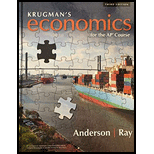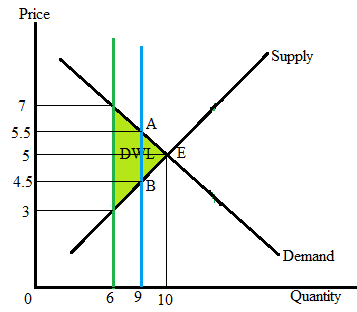
The question requires us to identify the price of a rise, the quota rent, and the
Explanation of Solution
The following graph represents the

Here,
Without quota, the market is producing at point E where:
When the government sets the quota at 6 million rides,
a) The demand price = price of the ride = $7 per ride
The supply price = $3 per ride.
b) Quota rent = demand price − supply price = $7 − $3 = $4 per ride.
The colored area represents the deadweight loss in the market due to the quota.
The deadweight loss is $8 million.
d) When quota increases to 9 million rides:

When the government sets the quota at 6 million rides,
a) The demand price = price of the ride = $5.5 per ride
The supply price = $4.5 per ride.
b) Quota rent = demand price − supply price = $5.5 − $4.5 = $1 per ride.
The colored area represents the deadweight loss in the market due to the quota.
The deadweight loss is $0.5 million.
When the quota rises to 9 million rides, the deadweight loss and quota rent will fall.
A quote puts an upper limit on the quantity sold or purchased in a market. Quota brings inefficiency in the market by generating a deadweight loss. The price of the ride will be the
The difference between the supply price and the demand price represents the quota rent.
Want to see more full solutions like this?
Chapter 9 Solutions
Krugman's Economics For The Ap® Course

 Principles of Economics (12th Edition)EconomicsISBN:9780134078779Author:Karl E. Case, Ray C. Fair, Sharon E. OsterPublisher:PEARSON
Principles of Economics (12th Edition)EconomicsISBN:9780134078779Author:Karl E. Case, Ray C. Fair, Sharon E. OsterPublisher:PEARSON Engineering Economy (17th Edition)EconomicsISBN:9780134870069Author:William G. Sullivan, Elin M. Wicks, C. Patrick KoellingPublisher:PEARSON
Engineering Economy (17th Edition)EconomicsISBN:9780134870069Author:William G. Sullivan, Elin M. Wicks, C. Patrick KoellingPublisher:PEARSON Principles of Economics (MindTap Course List)EconomicsISBN:9781305585126Author:N. Gregory MankiwPublisher:Cengage Learning
Principles of Economics (MindTap Course List)EconomicsISBN:9781305585126Author:N. Gregory MankiwPublisher:Cengage Learning Managerial Economics: A Problem Solving ApproachEconomicsISBN:9781337106665Author:Luke M. Froeb, Brian T. McCann, Michael R. Ward, Mike ShorPublisher:Cengage Learning
Managerial Economics: A Problem Solving ApproachEconomicsISBN:9781337106665Author:Luke M. Froeb, Brian T. McCann, Michael R. Ward, Mike ShorPublisher:Cengage Learning Managerial Economics & Business Strategy (Mcgraw-...EconomicsISBN:9781259290619Author:Michael Baye, Jeff PrincePublisher:McGraw-Hill Education
Managerial Economics & Business Strategy (Mcgraw-...EconomicsISBN:9781259290619Author:Michael Baye, Jeff PrincePublisher:McGraw-Hill Education





